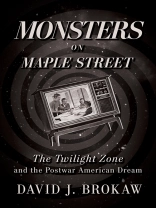Post-World War II America has often been mythologized by successive generations as an exceptional period of prosperity and comfort. At a time when the Cold War was understood to be a battle of ideas as much as military prowess, the entertainment business relied heavily on subtle psychological marketing to promote the idea of the American Dream. The media of the 1950s and 1960s promoted an idealized version of American life sustained by the nuclear family and bolstered by a booming consumer economy. The seemingly wholesome and simple lifestyles portrayed on television screens, however, belied a torrent of social, economic, and political struggles occurring at the time. By the late 1950s, television writers were increasingly constrained to distract audiences from confronting counternarratives to the Dream. Among the programs that railed against this trend was Rod Serling’s television masterpiece The Twilight Zone. Now considered an enduring classic, the allegorical nature of the show provides a window into the many overlooked issues that plagued Cold War America.
In Monsters on Maple Street: The Twilight Zone and the Postwar American Dream, David J. Brokaw describes how the TV show reframed popular portrayals of white American wish fulfillments as nightmares, rather than dreams. Brokaw’s close reading of the show’s sociopolitical dimensions examines how the series’ creators successfully utilized science fiction, horror, and fantasy to challenge conventional thinking – and avoid having their work censored – around topics such as sexuality, technology, war, labor and the workplace, and white supremacy. In doing so, Brokaw helps us understand how the series exposed the underbelly of the American Dream and left indelible impressions in the minds of its viewers for decades to come.
Mục lục
Introduction: The Twilight Zone, A Socially Critical Fantasy
1. Living in the Shadows of White Supremacy
2. Fighting a War, Combating a Myth: How the Horrors of World War II Shaped The Twilight Zone
3. Cold War Space and Technology: A Fertile Frontier or a New Human Wasteland?
4. Duck, Cover, and Accuse: Cold War Paranoia Remakes the American Landscape
5. Cold War Childhood: Containment or Entanglement?
6. White Collar Weariness: Postwar Work and Leisure Transformed
7. Consuming Conformity: The Planned Obsolescence of Selfhood in Postwar America’s Marketplace
8. Conclusion: ‘These Things Cannot Be Confined to The Twilight Zone’
Giới thiệu về tác giả
David J. Brokaw is professor of history at the University of Advancing Technology.












